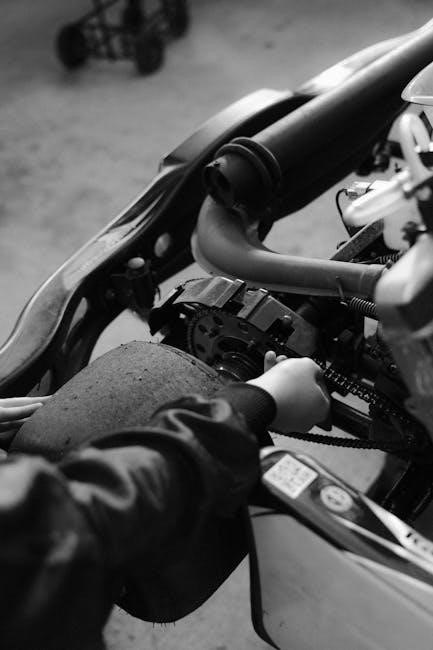
clutch ajustment on a 1950 3 speed manual trans
To adjust the clutch on a 1950 3-speed manual transmission, follow proper steps for optimal performance and smooth gear changes, using the Hudson Automatic Transmission Service Manual as a guide for reference purposes only always.
Understanding the Clutch System
The clutch system in a 1950s vehicle facilitates disengagement of the engine from the transmission, allowing for smooth gear changes and efficient power delivery. The clutch system consists of several components, including the clutch lever, clutch cable, and clutch assembly. To understand the clutch system, it is essential to familiarize yourself with the various parts and their functions. The clutch lever is typically located on the clutch pedal, and the clutch cable connects the lever to the clutch assembly. The clutch assembly includes the clutch disc, pressure plate, and release bearing. By understanding how these components work together, you can better diagnose and adjust the clutch system for optimal performance. The Hudson Automatic Transmission Service Manual provides valuable information on the clutch system and its components, which can be useful for reference purposes. Proper understanding of the clutch system is crucial for adjusting the clutch on a 1950 3-speed manual transmission.

Determining the Proper Adjustment Method
Proper adjustment method involves consulting the Hudson manual for specific instructions and guidelines always using correct techniques.
Locating the Adjusting Screws
To locate the adjusting screws, refer to the clutch system diagram in the Hudson Automatic Transmission Service Manual, which provides a detailed illustration of the clutch components and their locations. The adjusting screws are typically located on the ends of the clutch throwout arms, and are used to regulate the clutch engagement and disengagement. It is essential to identify the correct screws to avoid mistakenly adjusting other components. The Hudson manual provides specific information on the location and function of the adjusting screws, making it a valuable resource for this process. By consulting the manual and following the instructions, you can successfully locate the adjusting screws and proceed with the adjustment process. The correct location of the adjusting screws is crucial for proper clutch adjustment, and the Hudson manual offers the necessary guidance to ensure accurate and effective adjustments.

Transmission Fluid Service Instructions
Transmission fluid service instructions are found on pages 87-88 of the Hudson manual, providing guidance on proper fluid maintenance and replacement procedures always using correct methods.
Adjusting the Transmission Linkage
To adjust the transmission linkage, refer to the service manual for specific instructions, as the process can vary depending on the vehicle make and model, such as the 1950 3-speed manual transmission.
The Hudson manual provides detailed information on adjusting the transmission shifting levers, which is crucial for smooth gear changes and efficient power delivery.
The adjustment process typically involves locating the adjusting screws or bolts, loosening the locknut, and turning the adjuster nut to achieve the desired setting.
It is essential to follow the recommended procedures to avoid damaging the transmission or other components, and to ensure proper alignment and functioning of the linkage.
By adjusting the transmission linkage correctly, drivers can experience improved performance, reduced wear on the transmission, and a smoother driving experience overall, making it an important aspect of clutch adjustment and maintenance on a 1950 3-speed manual transmission.
The service manual should be consulted for specific guidance on adjusting the transmission linkage, as well as for any troubleshooting or repair procedures that may be necessary.
Proper adjustment of the transmission linkage is critical for optimal performance and longevity of the vehicle.

Part 2 of 3: Adjust the Clutch Cable
Locate the clutch lever and adjustment locations on the clutch cable for proper adjustment always using the correct procedure.
Clutch Cable Adjustment Locations
The clutch cable adjustment locations are typically found near the clutch lever and the transmission, and may require removal of parts such as the battery and airbox to access.
The adjustment locations usually consist of a locknut and an adjuster nut, which must be properly adjusted to ensure smooth clutch operation.
According to the Hudson Automatic Transmission Service Manual, the adjustment procedure involves loosening the locknut and turning the adjuster nut to achieve the proper clutch cable tension.
It is essential to follow the correct procedure to avoid damaging the clutch or transmission components.
The clutch cable adjustment locations may vary depending on the vehicle make and model, so it is crucial to consult the service manual or a repair guide for specific instructions.
Additionally, the clutch cable adjustment should be performed in conjunction with other maintenance tasks, such as checking the transmission fluid level and adjusting the transmission linkage.
By following the correct procedure and using the correct tools, the clutch cable adjustment can be completed successfully, resulting in smooth and efficient clutch operation.
The adjustment process requires patience and attention to detail to ensure that the clutch cable is properly adjusted.

Final Adjustment and Testing
Test the clutch by shifting through gears, checking for smooth engagement and disengagement, using the Hudson manual as a reference for proper procedure always and carefully.
and Additional Tips
To ensure proper clutch adjustment on a 1950 3-speed manual transmission, it is essential to follow the steps outlined in! the Hudson Automatic Transmission Service Manual, which provides detailed instructions for adjusting the transmission shifting levers. Additionally, it is crucial to check the transmission fluid level and condition, as well as the clutch cable and linkage, to prevent any potential issues. The Hudson manual also provides information on adjusting the transmission linkage, which is critical for smooth gear changes. By following these tips and guidelines, you can ensure optimal performance and extend the life of your transmission. It is also recommended to consult with a professional mechanic if you are unsure about any aspect of the adjustment process. Furthermore, regular maintenance and inspections can help identify potential problems before they become major issues, saving you time and money in the long run, and ensuring your vehicle runs smoothly and efficiently always.